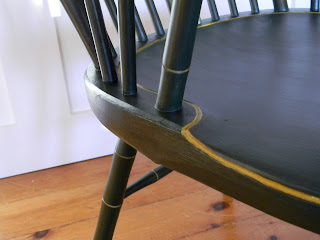Here's a shot of the technique I use for painting the small rod back Conifer Green. Like all things I know how to do, I learned by making mistakes. I like to pick out the nodes on the bamboo legs and such (these are made by a quick V-groove cut with a skew at the lathe, the deeper, the easier to paint) and the first time I did it, it picked them out with a small paint brush after painting, never again. Now I paint the chair Mustard or Marigold milk paint, then I paint it barn red. The Conifer (or peacock or whatever) just doesn't seem to cover the yellow. So a coat or two of barn red over the mustard, and if the conifer doesn't cover, the barn red actually looks good coming thru the top color.
Here's a good look at the yellow nodes on the legs and stumps. Another trick is to mix the milk paint fairly thick, say 2 parts powder to 3 parts water, and when I paint, hold the brush at a fairly flat angle relative to the leg, in other words, so the handle is almost parallel to the leg as opposed to perpendicular. This keeps the paint out of the groove. Also, run the brush fairly dry. I keep some newspaper handy to dab the brush on when I think there's too much paint in the brush. The gutter usually has to be touched up a little, the groove is too wide to keep the paint out.
Here's the last hint, a round, densely packed brush from Lee Valley. It's the mixed bristle 21mm size. I cut the handle at about 5 inches so it doesn't get hung up on the undercarriage. The shape and densely packed bristles makes it a lot easier to paint round stuff like the spindles and legs etc.. the bristle don't split apart like a regular flat brush will.
Another thing is to resist the temptation to touch up the paint as you go. If you miss a spot or if something doesn't look right, it's usually better to leave it, and fix it on the next coat. If you fix it right off, you end up with an extra coat which stick out like a sore thumb. Believe me on this one.



No comments:
Post a Comment